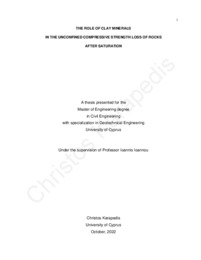| dc.contributor.advisor | Ioannou, Ioannis | en |
| dc.contributor.author | Karapedis, Christos | en |
| dc.coverage.spatial | Cyprus | en |
| dc.creator | Karapedis, Christos | en |
| dc.date.accessioned | 2023-02-09T11:51:33Z | |
| dc.date.available | 2023-02-09T11:51:33Z | |
| dc.date.issued | 2022-10 | |
| dc.identifier.uri | http://gnosis.library.ucy.ac.cy/handle/7/65454 | en |
| dc.description.abstract | The mechanical characteristics of rocks, such as their strength, elastic modulus, porosity and permeability, have been found to be reduced in the presence of water.
Researches have been contacted in a range of rock types, mostly in sedimentary rocks; igneous and metamorphic rocks have been lesser investigated. From all of
the available literature, it has been found that indeed water has a negative effect on such properties However, the magnitude of it is not well defined, since the range of
the reduction is great through different rock types, or even into the same rock type. In the present thesis, the role of clay minerals in the unconfined compressive
strength reduction of rocks is investigated. The survey starts with providing the basic background of clay mineral structure and behavior, after hydration. The basic aspects investigated, are the mechanisms related to clay minerals, the unconfined compressive strength loss magnitude at different saturation degrees, as well as at wetting and drying cycles, the saturation time influence, and how the strength loss behavior changes when saturated with cationic solutions. For that, two rock groups investigated, with the first group being rocks with high clay content (mudstones, siltstones and marls), and the second one being sandstones alone, in order to compare the different behavior presented by the two groups, concerning their mineral content. After that, it is suggested that for rocks with high clay content, the wet behavior of clay is the basic reason for the strength loss. Such statements cannot be made for sandstones; however, clay seems to have an impact in sandstone strength as well.
After statistical analysis, no clear relation was found between clay content and strength loss, for both groups. After discussion, author suggested that the clay mineral itself is not sufficient enough to indicate a strong correlation, instead, the clay content should be studied in addition to the pore space, for both groups. Other mechanisms affecting the strength reduction are presented in Appendixes. These mechanisms concern the presence of quartz and calcite, as well as the pore water itself | en |
| dc.language.iso | eng | en |
| dc.publisher | Πανεπιστήμιο Κύπρου, Πολυτεχνική Σχολή / University of Cyprus, Faculty of Engineering | |
| dc.rights | info:eu-repo/semantics/openAccess | en |
| dc.rights | Open Access | en |
| dc.title | The role of clay minerals in the unconfined compressive strength loss of rocks after saturation | en |
| dc.type | info:eu-repo/semantics/masterThesis | en |
| dc.contributor.committeemember | Ioannou, Ioannis | en |
| dc.contributor.department | Τμήμα Πολιτικών Μηχανικών και Μηχανικών Περιβάλλοντος / Department of Civil and Environmental Engineering | |
| dc.subject.uncontrolledterm | CLAY MINERALS | en |
| dc.subject.uncontrolledterm | UCS | en |
| dc.subject.uncontrolledterm | UNCONFINED COMPRESSIVE STRENGTH | en |
| dc.subject.uncontrolledterm | ROCK | en |
| dc.subject.uncontrolledterm | SANDSTONE | en |
| dc.subject.uncontrolledterm | MUDSTONE | en |
| dc.subject.uncontrolledterm | MARL | en |
| dc.subject.uncontrolledterm | CLAYSTONE | en |
| dc.subject.uncontrolledterm | SILTSTONE | en |
| dc.author.faculty | Πολυτεχνική Σχολή / Faculty of Engineering | |
| dc.author.department | Τμήμα Πολιτικών Μηχανικών και Μηχανικών Περιβάλλοντος / Department of Civil and Environmental Engineering | |
| dc.type.uhtype | Master Thesis | en |
| dc.contributor.orcid | Ioannou, Ioannis [0000-0002-8004-4913] | |
| dc.gnosis.orcid | 0000-0002-8004-4913 | |

